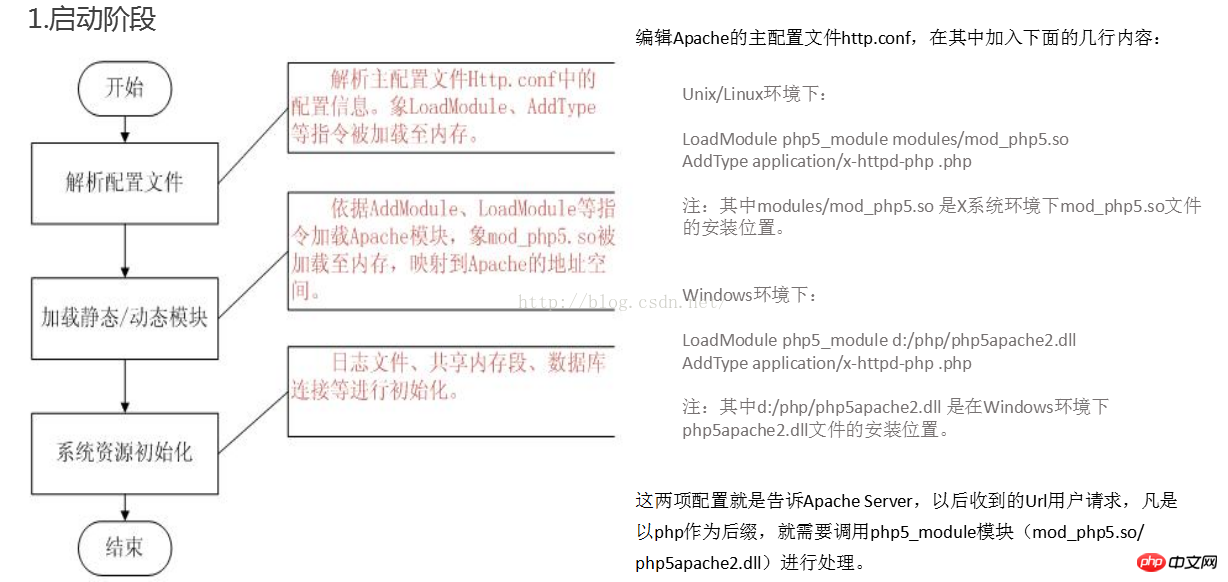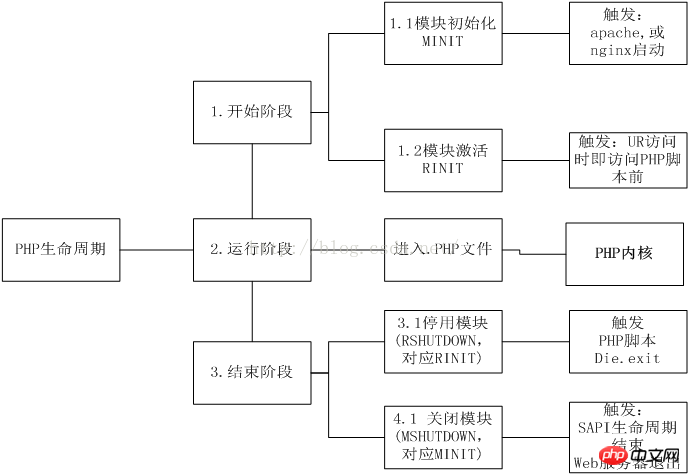
This article mainly introduces the PHP life cycle. Before understanding the PHP life cycle, you need to understand how Apache is related to PHP. Interested friends can refer to it. I hope it will be helpful to everyone.
1.Analysis of Apache operating mechanism

-----------------------------



#The overall diagram is as follows:

such as mod_php5.so, mod_perl.so, etc.) inject custom functions into the request processing loop. In other words, the module can hook its own processing function in any processing stage of Apache, thereby participating in Apache's request processing process.
mod_php5.so/ php5apache2.dll is to inject the included custom functions into Apache through the Hook mechanism, and is responsible for processing php requests at each stage of the Apache processing process. .
#Now that we know how apache hooks to php, let’s take a look at the process logic after apache transfers to PHP.
PHP start and end phases
After PHP starts executing It goes through two main phases: the beginning phase before processing the request and the ending phase after the request.

##2.1 SAPI runs PHP Several stages passed
Module initialization phase (Module init)
That is to call the method in PHP_MINIT_FUNCTION in each extension source code to initialize the module, apply for some variables required by the module, allocate memory, etc.
Request initialization phase (Request init)
After receiving the client’s request Call the method in PHP_RINIT_FUNCTION of each extension to initialize the execution environment of the PHP script.
Execute the PHP script (this step should be familiar to most PHP programmers, and the code you write is executed here)
Request Shutdown
At this time, call the PHP_RSHUTDOWN_FUNCTION method of each extension to clean up the request site, and ZE begins to recycle variables and memory
Close the module (Module shutdown)
When the Web server exits or the command line script is executed, the PHP_MSHUTDOWN_FUNCTION method in the extension source code will be called
##After the following steps: Start - Request starts - Request closes - End the SAPI interface implementation to complete its life cycle

##2.2 Starting phase
2.2.1 Module initialization Phase MINIT
# during the entire SAPI life cycle (for example, after Apache starts During the entire life cycle or the entire execution process of the command line program),
this process is only performed once.
After starting Apache, the PHP interpreter also starts;
PHP calls the MINIT method of each extension (module), thereby switching these extensions to an available state.//This is also the reason why apache must be restarted when a new dll module is introduced. php.ini
#
PHP_MINIT_FUNCTION(myphpextension)
{
// 注册常量或者类等初始化操作
return SUCCESS;
}
## 该过程发生在请求阶段, 例如通过url请求某个页面,则在每次请求之前都会进行模块激活(RINIT请求开始)。 请求到达之后,SAPI层将控制权交给PHP层,PHP初始化本次请求执行脚本所需的环境变量 例如是Session模块的RINIT,如果在php.ini中启用了Session 模块,那在调用该模块的RINIT时就会初始化$_SESSION变量,并将相关内容读入; 然后PHP会调用所有模块RINIT函数,即“请求初始化”。 在这个阶段各个模块也可以执行一些相关的操作, 模块的RINIT函数和MINIT函数类似 ,RINIT方法可以看作是一个准备过程,在程序执行之前就会自动启动。 2.3结束阶段 请求处理完后就进入了结束阶段, 一般脚本执行到末尾或者通过调用exit()或者die()函数,PHP都将进入结束阶段. 和开始阶段对应,结束阶段也分为两个环节,一个在请求结束后(RSHUWDOWN),一个在SAPI生命周期结束时(MSHUTDOWN).、 2.3.1请求结束后(RSHUWDOWN) 请求处理完后就进入了结束阶段,PHP就会启动清理程序。 它会按顺序调用各个模块的RSHUTDOWN方法。 RSHUTDOWN用以清除程序运行时产生的符号表,也就是对每个变量调用unset函数。 2.3.2 SAPI生命周期结束时(MSHUTDOWN) 最后,所有的请求都已处理完毕 SAPI也准备关闭了 PHP调用每个扩展的MSHUTDOWN方法 这时各个模块最后一次释放内存的机会。 (这个是对于CGI和CLI等SAPI,没有“下一个请求”,所以SAPI立刻开始关闭。)PHP_RINIT_FUNCTION(extension_name) {
/* Initialize session variables, pre-populate variables, redefine global variables etc */
}
PHP_RSHUTDOWN_FUNCTION(extension_name) {
/* Do memory management, unset all variables used in the last PHP call etc */
}
PHP_MSHUTDOWN_FUNCTION(extension_name) {
/* Free handlers and persistent memory etc */
}

The entire PHP life cycle is over. It should be noted that "starting the first step" and "closing the second step" will only be executed when there is no request from the server.
Related recommendations:
##thinkPHP5.0 framework application request life cycle analysis
Vue component life cycle usage method
##React How long is the life cycle of Native components
#
The above is the detailed content of PHP life cycle analysis. For more information, please follow other related articles on the PHP Chinese website!




